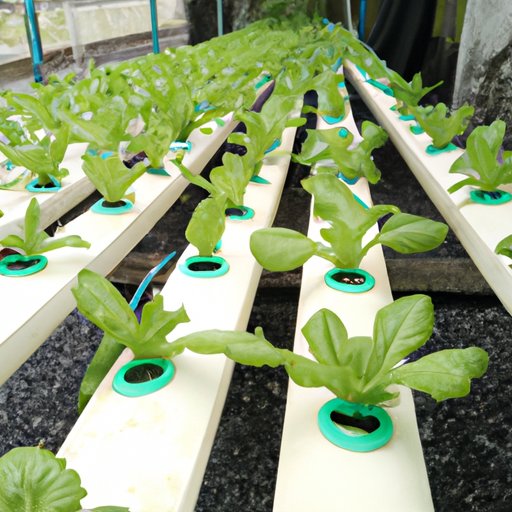Introduction
Hydroponics is a sustainable farming method that involves growing plants without soil, using water and mineral nutrients. This method allows farmers to grow plants faster, in a controlled environment, and with minimal use of water and fertilizers. Hydroponics is gaining popularity due to its potential to address key challenges faced by traditional farming practices, such as soil degradation, water scarcity, and climate change.
The Beginner’s Guide to Hydroponics
Hydroponics involves growing plants in a liquid medium, without soil. Nutrients are added to the water to provide plants with the necessary minerals for growth. This method allows farmers to control the growing conditions, including temperature, light, and nutrients. Hydroponic systems can range from simple setups, such as a passive hydroponic system, to more complex systems involving pumps, timers, and automation.
There are six main types of hydroponic systems:
- Nutrient Film Technique (NFT)
- Drip Irrigation System
- Wick System
- Deep Water Culture (DWC)
- Ebb and Flow System
- Aeroponic System
Each system has its pros and cons, and the choice depends on the crop being grown, the size of the operation, and the available resources. Hydroponic farming requires some basic equipment, such as grow lights, a reservoir, growing medium, nutrient solution, and pH testing kit. Many hydroponic systems are easy to set up and require minimal maintenance.
Hydroponic farming offers several benefits. It allows farmers to produce crops faster and with higher yields compared to traditional farming methods. Hydroponics uses less water than traditional agriculture and eliminates soil erosion. There is also reduced reliance on fertilizers, pesticides, and other agrochemicals, resulting in healthier produce. Hydroponic farming is versatile and can be done in any environment, including urban and indoor locations.
Sustainability and Hydroponics
Hydroponic farming is a more sustainable alternative to traditional farming. It promotes water conservation by using up to 90% less water than conventional agriculture. Hydroponic systems also eliminate soil erosion, which causes nutrient depletion and reduces soil productivity. Additionally, hydroponic farming reduces the need for chemical fertilizers and pesticides, preventing environmental pollution and minimizing the health risks associated with these agrochemicals.
Compared to traditional farming, hydroponic systems require less space and offer higher yields. They can be located in urban areas, reducing transportation costs and carbon emissions associated with food transportation.
Hydroponic Growing: A Boon for Urban Agriculture
Urban agriculture faces several challenges, including limited space, contamination, and limited access to water. Hydroponic farming is revolutionizing urban agriculture by providing a sustainable solution to these challenges. Hydroponic systems take up less space than traditional farming and are easily adaptable to small urban locations. They also reduce the environmental impact of urban agriculture by preventing soil contamination and reducing water usage. Hydroponic systems can be integrated into existing buildings, such as rooftops, improving food security in urban areas.
The benefits of hydroponic farming for urban areas include eliminating the need for transportation, reducing the carbon footprint, and improving access to fresh produce. Hydroponics can help make cities more sustainable and resilient to the impacts of climate change.
Maximizing Yield through Hydroponic Farming
Hydroponic farming is beneficial for commercial operations because it offers higher yields, increased efficiency, and lower costs. Hydroponic systems are designed to produce larger crops than traditional farming methods in a shorter time. The controlled environment of hydroponic systems allows for fewer pests and diseases, resulting in healthier and higher yielding crops. Hydroponics allows for extended growing seasons, allowing farmers to continuously produce crops throughout the year. Hydroponic systems are also scalable, making it easier to adapt to changing production demands.
Hydroponic farming is more resource-efficient than traditional agriculture, requiring up to 10 times less space, water, and other resources. As a result, hydroponic farming has lower costs and offers better return on investment, making it an attractive option for commercial farmers.
The Future of Farming: How Hydroponic Systems are Redefining Agriculture
Hydroponic farming offers a promising future for addressing global agriculture challenges, including population growth and climate change. With the world’s population expected to reach 9.7 billion by 2050, hydroponics can help meet the growing demand for food while preserving natural resources. Hydroponic systems allow farmers to grow crops in areas with limited resources, reducing the need for land and water-intensive traditional farming.
Traditional farming practices are also facing the challenge of climate change, which is reducing crop yields due to increased droughts, floods, and extreme weather events. Hydroponics provides sustainable solutions to these challenges by providing a controlled and efficient environment for crop growth. By using less water, eliminating soil erosion, and reducing CO2 emissions, hydroponic farming reduces the environmental impact of agriculture.
Conclusion
Hydroponics is a sustainable farming method that holds the key to meeting global agriculture challenges. With its ability to produce higher yields, conserve water, and reduce environmental impact, hydroponic farming is gaining popularity across the world. Hydroponic systems also offer a solution for urban agriculture challenges and have potential for use in commercial operations. As we head towards a future of food scarcity and climate change, hydroponic farming is a promising solution for ensuring food security, reducing environmental impact, and meeting the growing food demand of a global population.
